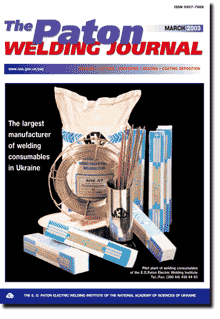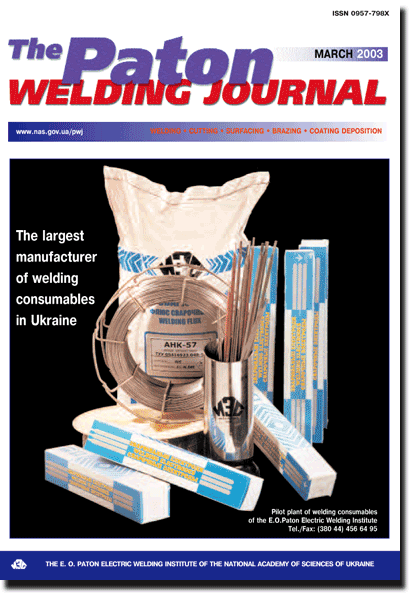

(You are viewing the simplified file contents)
AS = «Automatic Welding» - 6 issues per year;
TPWJ = «PATON WELDING JOURNAL» - 12 issues per year;
SEM = «Electrometallurgy Today» - 4 issues per year;
TDNK = «Technical Diagnostics and Non-Destructive Testing» - 4 issues per year.


| SCIENTIFIC AND TECHNICAL | |
| Pokhodnya I.K. Welding consumables: State-of-the-art and tendencies of development. | 2 |
| Data are presented about today production and consumption of steel in different regions of the world. The progress in machine-building, shipbuilding, civil engineering and other branches will require the reduction in mass of welded structures, increase in their reliability and life, reduction in energy consumption in welding operations. The above-mentioned problems can be solved by using high-strength low-alloy (HSLA) steels in critical structures. Data are given about the state-of-the-art of metallurgy and technology of HSLA welding in Russia and Ukraine. The problems of welding HSLA steels and tendencies of their development are considered and trends for their further investigation are formulated. State-of-the-art of development of general-purpose welding consumables is described and recommendations for their improvement are given. | |
| Pereplyotchikov E.F., Ryabtsev I.A. and Gordan G.M. High-vanadium alloys for plasma-powder cladding of tools. | 14 |
| Structure, hardness and wear resistance of two groups of iron-base high-carbon high-vanadium alloys with a different chromium content (5-7 and 14-17 %) are considered. Among the high-carbon high-vanadium alloys, the materials with a martensitic structure and a small amount of retained austenite, as well as with dispersed, uniformly distributed vanadium carbides and carbides of the Me23C6 type, were found to have the highest wear resistance under the abrasive wear conditions. | |
| Labur T.M. Strength and toughness of metal of welded joints in Al-Li alloys. | 18 |
| The paper deals with the regularities of variation of the strength and toughness of welded joints in Al-Li alloys, depending on the composition of the base and filler materials, heat input in welding, structure and operating conditions. | |
| Borisov Yu.S. and Kolisnichenko O.V. Effect of parameters of heating the surface of a part on structure of hardened layers of steel U8 in plasma-detonation treatment. | 22 |
| Temperature fields of surface layers during the process of plasma-detonation treatment of parts were determined on the basis of solving the non-stationary equation of thermal conductivity by the finite difference method. The resulting calculation dependencies were used to analyse kinetics of phase transformations in structure of steel U8 during PDT. | |
| INDUSTRIAL | |
| Barvinko A.Yu. and Gotsulyak E.A. Determination of admissible deviations of inserts in replacement of an assembly joint in the wall of coiled tanks. | 27 |
| The paper deals with restoration of the serviceability of vertical assembly joints of the wall of coiled tanks by successive cutting out of the sections of aligned welds and welding rectangular inserts into the girths. It is shown that insert deviation from the design position induces additional local stresses along the vertical line of transition from the insert to the shell, as well as in the insert center, which requires establishing certain deviation tolerances. A criterion is suggested to determine the tolerances for deviation of rectangular inserts from the design position. | |
| Tarnogrodsky V.P. and Ponomaryova E.Yu. Ways of increasing strength of welded joints in tubes of thermoplastic materials (Review). | 32 |
| Methods for increasing strength of welded joints in tubes of thermoplastic materials are reviewed. These methods are based on removal of oxide film by shearing it during welding of plastics using IR-radiation, application of a profiled hot tool and mechanical stirring. | |
| Chernykh V.V. Competence of personnel is an important component of the system of ecological safety of welding production. | 35 |
| Experience of interaction of Russian Research and Development Welding Society with similar world-level European structures in the field of personnel training is described. Coordinating role of the Inter-State Council for Welding and Related Technologies is shown. Provisions of the European certification schemes on quality and environment management systems are given. | |
| Lebedev V.A. Special features of designing mechanisms of pulsed feed of electrode wire in welding equipment. | 39 |
| Some features of development and design of mechanisms of pulsed feed of electrode wire are described. Serious problems are considered, arising at high accelerations in the pulse and at variable feed rates, which consist in the need to reproduce the pulse parameters, set by the electrode wire at its interaction with the feed rollers, lowering the level of mechanism vibrations, affecting the mechanical reliability of the mechanism and the conditions of conducting the welding process. Methods to improve the operating conditions of pulsed feed mechanism are demonstrated. | |
| BRIEF INFORMATION | |
| Shlepakov V.N. and Bilinets A.V. Flux-cored wires with metal core for gas-shielded welding. | 44 |
| Considered are the issues associated with development of new flux-cored wires with a metal core, combining high deposition efficiency and high yield of the deposited metal. The use of a thick-walled sheath provides excellent feed of the wire. | |
| Zhadkevich M.L. and Trofimyak V.N. Installation for magnetron sputtering of coatings on glass panels. | 45 |
| The paper deals with an all-purpose unit for magnetron sputtering for applying the reflecting and other kinds of coatings on sheet materials. | |
| Process of consumable-electrode welding with programmable change of gas shielding and welding current modulation. | 47 |
| Advertising. | 48 |
(You are viewing the simplified file contents)
The cost of subscription/purchase order journals or individual articles
| Journal/Currency | Annual Set | 1 issue printed |
1 issue |
one article |
| AS/UAH | 1800 UAH | 300 UAH | 300 UAH | 150 UAH |
| AS/USD | 192 $ | 32 $ | 26 $ | 16 $ |
| AS/EUR | 180 € | 30 € | 25 € | 15 € |
| TPWJ/UAH | 7200 UAH | 600 UAH | 600 UAH | 280 UAH |
| TPWJ/USD | 384 $ | 32 $ | 26 $ | 16 $ |
| TPWJ/EUR | 360 € | 30 € | 25 € | 15 € |
| SEM/UAH | 1200 UAH | 300 UAH | 300 UAH | 150 UAH |
| SEM/USD | 128 $ | 32 $ | 26 $ | 16 $ |
| SEM/EUR | 120 € | 30 € | 25 € | 15 € |
| TDNK/UAH | 1200 UAH | 300 UAH | 300 UAH | 150 UAH |
| TDNK/USD | 128 $ | 32 $ | 26 $ | 16 $ |
| TDNK/EUR | 120 € | 30 € | 25 € | 15 € |
AS = «Automatic Welding» - 6 issues per year;
TPWJ = «PATON WELDING JOURNAL» - 12 issues per year;
SEM = «Electrometallurgy Today» - 4 issues per year;
TDNK = «Technical Diagnostics and Non-Destructive Testing» - 4 issues per year.

